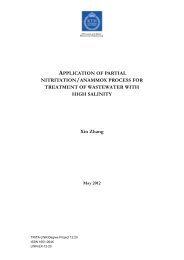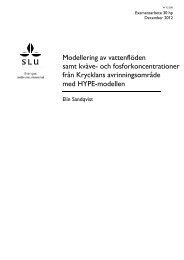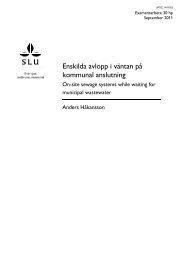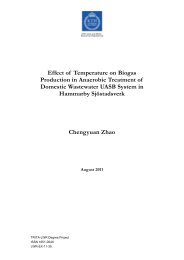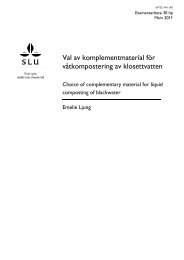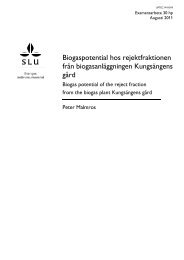Exergy saving and exergy production in municipal wastewater ...
Exergy saving and exergy production in municipal wastewater ...
Exergy saving and exergy production in municipal wastewater ...
Create successful ePaper yourself
Turn your PDF publications into a flip-book with our unique Google optimized e-Paper software.
<strong>Exergy</strong> <strong>sav<strong>in</strong>g</strong> <strong>and</strong> <strong>exergy</strong> <strong>production</strong> <strong>in</strong> <strong>municipal</strong> <strong>wastewater</strong> treatment<br />
∆H s. (∆Sw) = substrates spent <strong>in</strong> biosynthetic activity<br />
∆H s. (-∆sc) = substrate used <strong>in</strong> cellular components<br />
1.18. Application of thermodynamic orientors<br />
Thermodynamic orienotrs mentioned above namely as emergy, <strong>exergy</strong><br />
<strong>and</strong> entropy plus calorie can be used to describe the metabolic activities<br />
of bacteria.<br />
1.19. Thermodynamic of growth<br />
Metabolism <strong>in</strong> Greek means change which <strong>in</strong> other words is the<br />
organism’s chemical processes to ma<strong>in</strong>ta<strong>in</strong> life. It is composed of<br />
catabolism <strong>and</strong> anabolism. The bacteria’s general cell composition is<br />
C 18H 19O 9N (Henze et al, 1996). Consequently it needs to take up these<br />
elements from its surround<strong>in</strong>g to keep its cell alive.<br />
The major energy source for the bacteria is carbon <strong>and</strong> the most<br />
available product for this element is glucose. Lipid is important <strong>in</strong> the<br />
structure <strong>and</strong> function<strong>in</strong>g of the cell membrane. Nitrogen is an essential<br />
element of am<strong>in</strong>o acids, nucleotides, prote<strong>in</strong> <strong>and</strong> DNA.<br />
The bacteria growth is a function of energy use of the released energy<br />
from the flow of electrons from the donors to the acceptors. However,<br />
the proton gradient between <strong>in</strong>side <strong>and</strong> outside of the membrane of the<br />
cell is the ma<strong>in</strong> drive of the ATP <strong>production</strong> (Franks <strong>and</strong> Nev<strong>in</strong>, 2010).<br />
Bacteria are be<strong>in</strong>g considered as open systems with irreversible processes<br />
<strong>in</strong> which energy <strong>and</strong> matter can path through the cell membrane. The<br />
dom<strong>in</strong>at<strong>in</strong>g species <strong>in</strong> the media are the ones which have been able to<br />
transfer electrons more rapidly <strong>and</strong> capture the most possible released<br />
energy from this process.<br />
The free energy of the electron at unit activity is considered as zero by<br />
convention. Typical electron acceptors are oxygen, nitrate, sulfate, <strong>and</strong><br />
carbon dioxide. With oxygen as the electron acceptor, the energy<br />
released from the electron transfer process is the highest; whereas, this<br />
energy is the lowest when the electron acceptor is carbon dioxide.<br />
Consider<strong>in</strong>g one cell metabolic reactions, follow<strong>in</strong>g equations can<br />
be considered (Fig.1) (Von Stockar et al, 2006):<br />
= entropy change <strong>in</strong>side the cell<br />
= rate of heat transfer between the cell <strong>and</strong> the environment<br />
= metabolites transferr<strong>in</strong>g <strong>in</strong>to <strong>and</strong> out of the cell<br />
= partial molar entropy of ith metabolite<br />
= molar rate of exchange of ith metabolite<br />
(24)<br />
= newly produced biomass leav<strong>in</strong>g the cell with molar rate of<br />
. denotes the partial molar entropy of the biomasses produced <strong>in</strong><br />
the cell, which is low due to highly organized matter be<strong>in</strong>g produced.<br />
= denotes the rate of entropy <strong>production</strong> by irreversible processes<br />
<strong>in</strong>side the cell (anabolism).<br />
Microbial growth is highly irreversible process as it happens<br />
spontaneously (Von Stockar et al, 2006). is highly positive <strong>and</strong> is<br />
the real driv<strong>in</strong>g force for the microbial growth. In fact, it is denot<strong>in</strong>g the<br />
negentropy or <strong>in</strong> other words the <strong>in</strong>formation created by the cell.<br />
17




